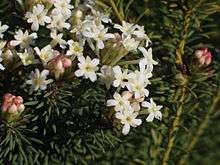Gnidia
| Gnidia | |
|---|---|
 | |
| Gnidia tomentosa | |
| Scientific classification | |
| Kingdom: | Plantae |
| (unranked): | Angiosperms |
| (unranked): | Eudicots |
| (unranked): | Rosids |
| Order: | Malvales |
| Family: | Thymelaeaceae |
| Genus: | Gnidia L. |
| Species | |
|
140-160, see text | |
Gnidia is a genus of flowering plants in the family Thymelaeaceae. It is distributed in Africa, Madagascar, Arabia, India, and Sri Lanka; more than half of all the species are endemic to South Africa.[1] Gnidia was named for Knidos, an Ancient Greek city located in modern-day Turkey.[2]
These are perennial herbs and shrubs, sometimes with rhizomes. Most species have alternately arranged leaves, and a few have opposite leaves. The leaves are undivided and unlobed. The inflorescence is a head of a few to many flowers. The calyx is cylindrical and the colored lobes may alternate with the petals; some species lack petals.[2] Many species are similar in appearance and difficult to tell apart.[3]
Molecular analyses have provided evidence that the genus is polyphyletic, made up of four different lineages. They are related to the four genera Struthiola, Drapetes, Lasiosiphon, and Pimelea.[4]
There are 140 to 160 species classified in the genus.[1][2][5]
Species include:


- Gnidia anthylloides
- Gnidia burchellii
- Gnidia caffra
- Gnidia capitata
- Gnidia carinata
- Gnidia chapmanii
- Gnidia chrysantha
- Gnidia chrysophylla
- Gnidia ericoides
- Gnidia fastigiata
- Gnidia humilis
- Gnidia insignis
- Gnidia involucrata
- Gnidia kraussiana
- Gnidia latifolia
- Gnidia microcephala
- Gnidia mollis
- Gnidia nana
- Gnidia ornata
- Gnidia pedunculata
- Gnidia polycephala
- Gnidia razakamalalana[1]
- Gnidia socotrana
- Gnidia sonderiana
- Gnidia spicata
- Gnidia squarrosa
- Gnidia usafuae
- Gnidia variabilis
- Gnidia virescens
References
- 1 2 3 Rogers, Z. S. (2006). A new species of Malagasy Gnidia and the lectotypification of Octolepis decalepis (Thymelaeaceae). Adansonia, sér. 3(28), 155-60.
- 1 2 3 Hyde, M. A., et al. Gnidia. Flora of Zimbabwe. 2013.
- ↑ Beaumont, A. J., et al. (2001). Patterns of diversity among involucral bracts, inflorescences and flowers in Gnidia (Thymelaeaceae). Systematics and Geography of Plants 71(2), 419-31.
- ↑ Beaumont, A. J., et al. (2009). Gnidia (Thymelaeaceae) is not monophyletic: taxonomic implications for Thymelaeoideae and a partial new generic taxonomy for Gnidia. Botanical Journal of the Linnean Society 160(4), 402-17.
- ↑ Bhandurge, P., et al. (2013). The Gnidia genus: A review. Asian Journal of Biomedical and Pharmaceutical Sciences 3(19), 1-31.
External links
- Species listing: Gnidia. Red List of South African Plants. South African National Biodiversity Institute (SANBI).